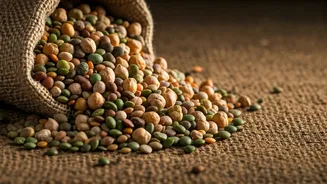Mission's Core Aims
The 'Mission for Aatmanirbharta in Pulses' is designed to make India self-reliant in pulse production. The primary goals revolve around significantly increasing
the yield of various pulses cultivated across the country. This means focusing on improved farming techniques, high-yielding varieties of seeds, and providing farmers with the necessary resources and knowledge. The mission's success is measured by the reduction in dependence on importing pulses from other countries, which helps strengthen the nation's food security. By producing more pulses domestically, India aims to stabilize prices and ensure their availability for all citizens. Furthermore, the initiative seeks to empower farmers by providing them with better economic opportunities through increased production and access to markets.
Boosting Production Strategies
To boost pulse production, the mission implements a multi-pronged approach. Firstly, it focuses on providing farmers with advanced agricultural practices. This encompasses using better irrigation systems, soil management techniques, and adopting modern technologies. Secondly, the program emphasizes the use of high-yielding and disease-resistant seed varieties. Research and development play a significant role in creating and distributing these superior seeds. Thirdly, the mission ensures that farmers have access to the necessary financial support. This includes providing credit facilities, subsidies on essential inputs such as fertilizers and pesticides, and insurance schemes to mitigate risks. Finally, the mission promotes the establishment of robust market linkages. This helps farmers to sell their produce at fair prices, reducing post-harvest losses and improving profitability.
Why Pulses Matter
Pulses hold a critical role in India's food security and the economy. They are a primary source of protein for a large population, making them essential for nutritional needs. Moreover, pulses are crucial for soil health as they fix nitrogen, reducing the need for chemical fertilizers and improving overall soil fertility. Self-sufficiency in pulses helps to stabilize the prices of these essential commodities in the domestic market, providing relief to consumers and protecting them from volatile international markets. Reduced reliance on imports helps the country save valuable foreign exchange. This promotes economic stability and boosts agricultural incomes. The mission also aims to encourage the cultivation of pulses in rain-fed areas, which will enhance the economic prospects of farmers in these regions, contributing to overall rural development.
Challenges and Impact
Despite its noble objectives, the 'Mission for Aatmanirbharta in Pulses' faces several challenges. Climate change, which leads to unpredictable weather patterns, poses a significant threat to pulse cultivation. Water scarcity in some regions can also affect crop yields, requiring efficient water management strategies. Furthermore, the availability of quality seeds and the adoption of modern farming practices among farmers require consistent training and education. The mission also addresses market access and infrastructure challenges, such as inadequate storage facilities and transportation. The successful implementation of the mission is expected to bring substantial benefits. It will likely reduce import dependency, enhance food security, and improve the livelihoods of farmers. This will contribute to the growth of the agricultural sector and strengthen the overall economy by promoting self-reliance and sustainable agricultural practices across India.














